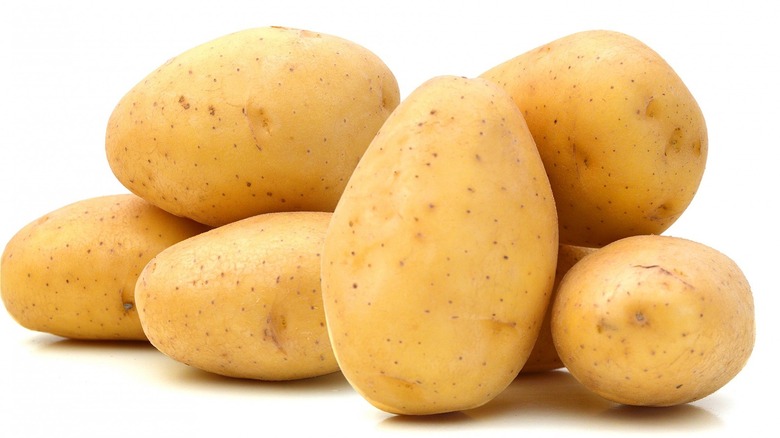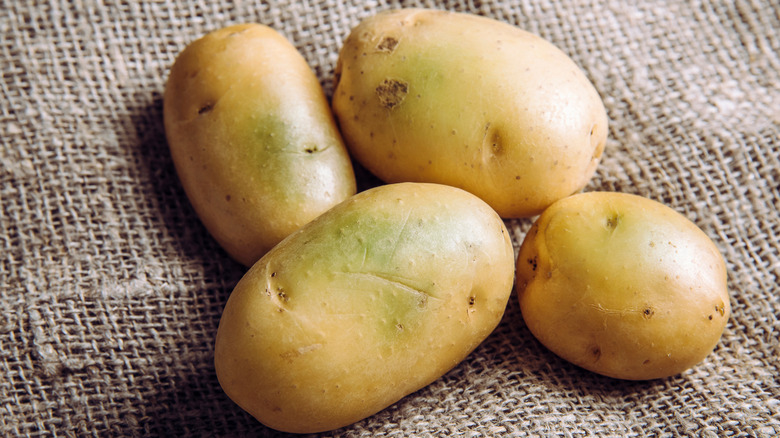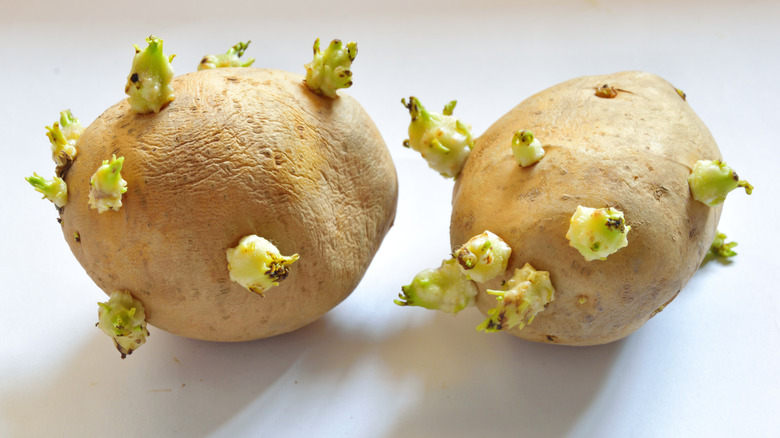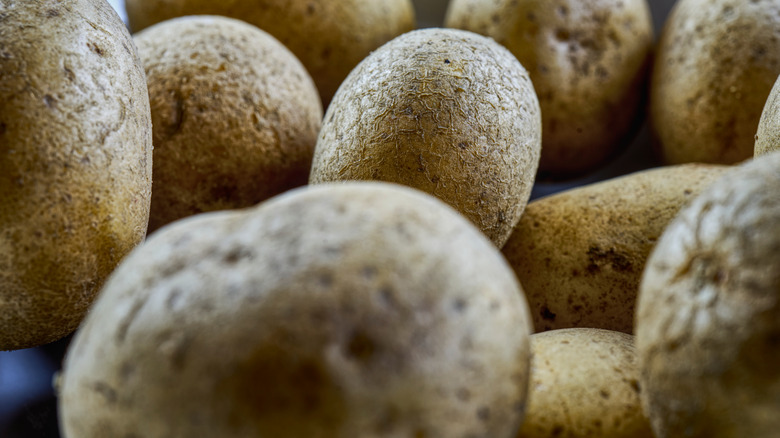How To Tell If Potatoes Have Gone Bad
When you reach into a bag of not-exactly-brand-new potatoes, you never know what your hand is going to pull out. (Well, okay, you might know your hand will pull out a potato.) You could get lucky and find a perfectly blemish-free Yukon gold, or you could yank out a distorted eye-riddled lump formerly known as a "potato." It really could go either way. But how can you tell which seemingly terrifying taters can still be cooked into "tots" and which ones should be tossed in the trash?
It is important to begin by establishing that eating a bad potato can actually make you sick. In fact, a spoiled potato contains high levels of solanine and ingestion can lead to solanine poisoning. Yes, it's a real thing and the symptoms — diarrhea, stomach cramps, vomiting, headache — are not pretty. In fact, Smithsonian Magazine shares the story of a British boys' school where 78 students fell terribly ill with solanine poisoning after consuming potatoes left over from months before. While they all made a full recovery, some spent time in a coma, and others suffered from hallucinations. Clearly, you and your family will want to give rotten potatoes a wide berth and these helpful tips will hopefully enable you to better identify which ones are keepers and which ones aren't.
Check for green
It is important for you to note that as Healthline points out, solanine "is normally present in low levels in the skin and flesh of potatoes." A potato at its prime is perfectly healthy to eat. The goal, then, is to establish what makes a potato less-than or past its prime. This brings us to the much-talked-about green potato. While potatoes with greenish skins have not actually "spoiled," there exists a great deal of chatter as to whether or not they should be tossed out.
Why do potatoes turn green? According to Medical News Today, exposure to light causes the potato to create chlorophyll. This causes them to have increased levels of solanine and turn a greenish hue. They go on to say that no one should eat a mostly green potato, but if there is just a bit of green, one can often cut that portion out and eat the rest. The Food Safety Authority of Ireland says that if a green potato "tastes bitter after peeling, it's best not to eat them." Healthline, on the other hand, contends that "once a potato has turned green, it's best to throw it away." And Britannica warns that children should never consume green potatoes. While there seems to be some leeway when it comes to handling a slightly greenish potato, it is clear that a mainly green one is a giant no-no. But what happens if your potato has sprouted?
Check for 'eyes'
One of the most common conditions that your potato can contract is the appearance of hard whitish-green sprouts, otherwise known as "eyes." It looks like it is metamorphizing into an alien lifeform, but it is actually experiencing increased levels of glycoalkaloid compounds — something equally sinister. Healthline says that when these compounds are eaten in lower doses, they can lead to diarrhea, abdominal pain, and throwing up, but when consumed at higher levels, they can lower your blood pressure, elevate your pulse, and give you a fever. And, in some cases, people have died.
So what does this mean for the fate of your potato-with-eyes? The National Capital Poison Center recommends that if you have a sprouted potato, you should throw it out. Bon Appétit contends that it all depends on how "sprouted" your potato is. If it's just started to sprout, you will likely only experience an unpleasant bitter taste, but if it has "large quantities" of sprouts, it could be toxic. Healthline points out that it is unclear whether discarding sprouts, eyes, or green skin is enough to protect you from toxic solanine levels every time. It would appear that no matter how tempted you may be to simply carve out the eyes and boil as per usual, it could be best to grab a fresh "eyeless" specimen, instead.
Check its flesh
Ideally, you want a potato that's skin is reasonably unblemished, the tuber equivalent of "as smooth as a baby's bottom." While perfect potatoes are a rarity, there are some telltale signs that it's too far gone to be healthy. If a potato is slightly soft, the Idaho Potato Commission says it is still perfectly safe to eat. If your potato is starting to look a bit too old — "soft, shriveled, and wrinkled" — it is an indicator that it is no longer edible. Potatoes shouldn't be weepy, have any signs of mold, possess deep black spots, or smell like anything other than earth. And if they are bruised like they've gone a round against Mohammed Ali, it's time to toss them.
While most home cooks may not view potatoes as a food that is overly hazardous when spoiled like chicken or pork, don't let this seemingly innocuous tuber fool you. By watching for a few telltale signs, you can ensure that nothing potentially dangerous is lurking in your next bowl of mashed potatoes.



